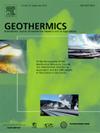Numerical analysis of heat transfer performance in medium-depth coaxial casing heat exchangers considering seepage effects
IF 3.5
2区 工程技术
Q3 ENERGY & FUELS
引用次数: 0
Abstract
This study presents an innovative analytical model for a 3000-meter-deep coaxial borehole heat exchanger (CBHE) that simultaneously considers geothermal gradients, geological stratification, groundwater seepage, and the vertical permeability of the seepage layer. By focusing on the annular fluid and its temperature response within the borehole layer, the model incorporates factors often neglected in previous research, including the influence of groundwater flow and the thermal property variations across different soil and rock layers. The results show that seepage significantly enhances heat transfer via distinct mechanisms. For instance, when the seepage layer is located at a depth of 2000 m, conduction-dominated heat exchange is critical at a seepage velocity of 5 × 10⁻⁷ m/s, whereas exceeding 1 × 10⁻⁵ m/s shifts the dominant mechanism to convective heat transfer, thereby increasing the local heat exchange intensity in the annular fluid by 56.7 %. Furthermore, optimizing the inner pipe's insulation length significantly enhances system efficiency by increasing the outlet temperature and reducing thermal losses. The study also establishes a relationship between seepage parameters and the necessary buried depth for achieving a given heat extraction. These findings offer valuable theoretical guidance for improving geothermal system performance and hold significant engineering implications for sustainable geothermal energy utilization.
考虑渗流效应的中深同轴套管换热器换热性能数值分析
本文提出了一种同时考虑地温梯度、地质分层、地下水渗流和渗流层垂向渗透率的3000米深同轴钻孔换热器(CBHE)分析模型。该模型通过关注井内环空流体及其温度响应,纳入了以往研究中经常被忽略的因素,包括地下水流动的影响以及不同土层和岩层的热物性变化。结果表明,渗流通过不同的机制显著增强了换热。例如,当渗流层位于2000米深处时,在5 × 10⁻m/s的渗流速度下,以传导为主导的热交换是关键的,而超过1 × 10⁻m/s的渗流速度将主要机制转变为对流传热,从而使环空流体的局部热交换强度增加56.7%。此外,优化内管的保温长度可以通过提高出口温度和减少热损失来显著提高系统效率。该研究还建立了渗流参数与实现给定热提取所需埋深之间的关系。这些发现为提高地热系统性能提供了有价值的理论指导,并对地热能源的可持续利用具有重要的工程意义。
本文章由计算机程序翻译,如有差异,请以英文原文为准。
求助全文
约1分钟内获得全文
求助全文
来源期刊

Geothermics
工程技术-地球科学综合
CiteScore
7.70
自引率
15.40%
发文量
237
审稿时长
4.5 months
期刊介绍:
Geothermics is an international journal devoted to the research and development of geothermal energy. The International Board of Editors of Geothermics, which comprises specialists in the various aspects of geothermal resources, exploration and development, guarantees the balanced, comprehensive view of scientific and technological developments in this promising energy field.
It promulgates the state of the art and science of geothermal energy, its exploration and exploitation through a regular exchange of information from all parts of the world. The journal publishes articles dealing with the theory, exploration techniques and all aspects of the utilization of geothermal resources. Geothermics serves as the scientific house, or exchange medium, through which the growing community of geothermal specialists can provide and receive information.
 求助内容:
求助内容: 应助结果提醒方式:
应助结果提醒方式:


